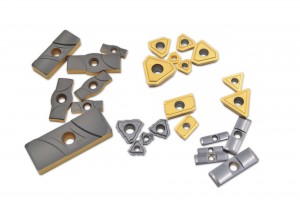The influence of blade material
The material of the blade determines its hardness, toughness, heat resistance and wear resistance, which directly affects the milling efficiency, tool life and processing quality.
Hard alloy (tungsten cobalt type): Most commonly used, it strikes a balance between hardness and toughness, suitable for processing steel, cast iron and stainless steel, but prone to wear at high temperatures.
Ceramic blades: high hardness, heat resistance, suitable for high-speed precision machining of hardened steel or high-temperature alloys, but they are brittle and have poor impact resistance.
Cubic boron nitride (CBN): A super-hard material, it is used for the fine processing of high-hardness materials such as quenched steel and cast iron. It has excellent wear resistance but is costly.
Diamond (PCD): Suitable for processing non-ferrous metals (such as aluminum, copper) and composite materials, sharp cutting edge, but prone to oxidation at high temperatures.
Material selection should match the workpiece material – high toughness inserts can be used for soft materials, while high hardness inserts are needed for hard materials to avoid chipping or rapid wear.
2. The Influence of Coatings
Coatings can significantly enhance the performance of blades, mainly improving wear resistance, heat resistance and lubricity. Common coating types include:
Titanium nitride (TiN): A general-purpose coating that reduces the coefficient of friction, suitable for processing steel parts, with a golden yellow color. It is low-cost but has average high-temperature resistance.
Titanium aluminum nitride (TiAlN): Excellent high-temperature resistance (up to 800°C), suitable for high-speed machining of cast iron, stainless steel, etc., with a purple-black appearance.
Chromium nitride (CrN): Strong anti-adhesion property, used for materials with high adhesion such as aluminum and titanium, reducing built-up edge.
Diamond coating: used for processing non-ferrous metals, extremely smooth surface, extends tool life, but not suitable for steel workpieces.
The coating reduces friction and heat insulation, lowers the cutting temperature, reduces tool wear, and improves surface finish at the same time. For instance, TiAlN coating can extend the tool life by 2 to 3 times in high-speed milling.
Overall effect
Wear resistance: Hard alloy + CBN coating is suitable for high-hardness workpieces; PCD coating for processing aluminum can prevent tool adhesion.
Cutting speed: Ceramic or TiAlN-coated inserts allow for higher rotational speeds, enhancing efficiency.
Surface quality: The smoothness of the coating reduces burrs and is suitable for precision machining.
A reasonable combination of materials and coatings can optimize milling efficiency, cost and quality, and the selection should be based on the workpiece material and processing conditions.
Post time: Jul-24-2025

